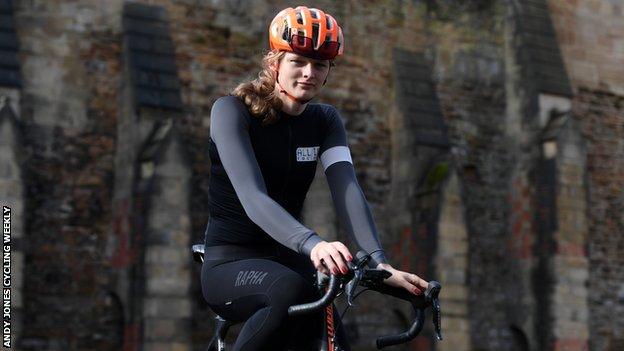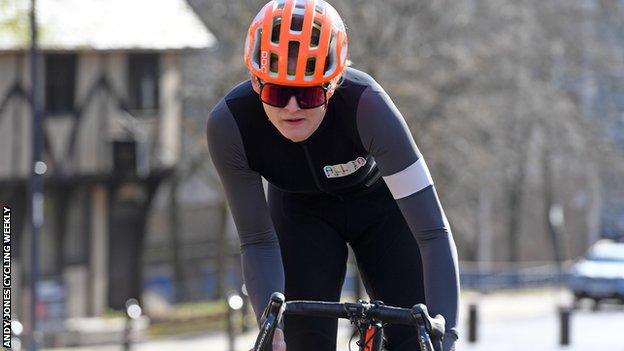Emily Bridges: Transgender cyclist set to race in women's National Omnium event
- Published

Emily Bridges hopes to compete in the National Omnium Championships in Derby this weekend
Transgender cyclist Emily Bridges looks set to compete against some of the sport's biggest names, including five-time Olympic champion Laura Kenny, at Saturday's National Omnium Championships in her first women's event.
Bridges, 21, began hormone therapy last year as part of her gender dysphoria treatment and has now become eligible to compete in women's events because of lowered levels of testosterone.
She is a provisional entry on the starting list for the event in Derby.
British Cycling's transgender regulations, which were updated in January this year, require riders to have had testosterone levels below five nanomoles per litre for a 12-month period prior to competition.
Bridges previously set a national junior men's record over 25 miles and was selected to join British Cycling's senior academy in 2019.
She first came out as transgender in an interview with Sky Sports, external in October 2020, and has spoken about wanting to change the culture and representation in elite cycling.
While having hormone therapy, Bridges continued to compete in men's races.
In May 2021 she finished 43rd out of 45 riders in the elite men's criterium at the Loughborough Cycling Festival and in September she was second to last in the Welsh National Championship road race, a 12km lap behind the winner. Last month, Bridges won a men's points race at the British Universities Championships in Glasgow - her final men's race.
"It was always the plan [to race in a women's event]," she told Cycling Weekly, external this month. "After starting hormone therapy I didn't want to race in the male category any more than I had to - obviously, it sucks, getting dropped, racing as a man when you're not one. It was quickly apparent that was the wrong category for me.
"By the summer of 2020 I'd fallen out of love with the sport. I couldn't live like that any more - I couldn't be my true self."
According to Cycling Weekly, Bridges has been participating in a study at Loughborough University to track her own power data with reduced testosterone levels - and says they show a 13-16% drop in her power outputs across six-second, one-minute, five-minute and 20-minute durations.
Bridges also says she has received a mixed response on speaking publicly about her transition, but that many female cyclists have sent messages of support.
British Cycling said the update to its policy on transgender athletes was issued following a "wide-ranging consultation".
A British Cycling spokesperson said: "We believe that the updated policy reflects the current evidence available to us, however we acknowledge that more research into this area is required.
"For this reason we have committed to reviewing our policy annually, or more frequently as evolving circumstances dictate."
Earlier this month, US college transgender swimmer Lia Thomas won the 500-yard freestyle and finished fifth and eighth in other races at the NCAA Championships.
Thomas was backed by an open letter from 300 swimmers, including rival Erica Sullivan, external - but her inclusion also faced opposition from another competitor - Hungary's Reka Gyorgy, as well as Florida governor Ron DeSantis.
Asked about the issue, World Athletics president Lord Sebastian Coe claimed the "integrity" of women's sport was at stake and its future was "fragile".
Coe also called on the International Olympic Committee (IOC) to introduce regulations that can be applied across every sport and insisted that "gender cannot trump biology".
Where are we with transgender inclusion in women's sport?

Emily Bridges in training
The most recent IOC guidance - updated in November 2021 after the Tokyo Olympics - said there should be no assumption that a transgender athlete automatically has an unfair advantage in female events.
It recommended that individual sports under the Olympic umbrella, such as athletics, weightlifting, gymnastics and swimming, make their own rules surrounding transgender athletes.
World Athletics has set five nanomoles per litre as its benchmark with cycling set at below five nanomoles.
World Rugby has banned trans women from playing at elite level, while the Rugby Football Union's domestic policy in England does allow trans women to play, under certain testosterone-based conditions.
The IOC guidelines have been criticised by some medical experts, 38 of whom signed a statement questioning the changes made to its policy around testosterone suppressants in transgender women.
The sporting body said relying on testosterone levels alone in female events was no longer deemed sufficient grounds to determine whether or not a competitor has an unfair advantage.
"You don't need to use testosterone [to decide who can compete] at all. But this is guidance, it's not an absolute rule," said IOC medical director Richard Budgett.
But some medical professionals said the guidance was drafted mainly from a human rights perspective with little consideration of medical and scientific issues.
There has also been new guidance around transgender inclusion in non-elite sport, created in 2021. It was published after an 18-month consultation and review of the existing research and was developed by Sport England, Sport Scotland, Sport Northern Ireland, Sport Wales and UK Sport.
It challenged sport bodies to "think in innovative and creative ways to ensure nobody is left out", and stipulates individual sports should choose between inclusion or "competitive fairness" - and safety if relevant.
The guidance suggests for those sports where safety or fairness could be compromised, the individual sports could create an "open" or "universal" category separate to male and female ones.
It said "testosterone suppression is unlikely to guarantee fairness between transgender women and natal females in gender-affected sports".
What are the rules in cycling?
British Cycling last updated its rules surrounding transgender athletes in January, detailing trans athletes need to have their testosterone below five nanomoles per litre for a year to compete against other women.
Men typically have between 10 and 30 nanomoles per litre depending on age and time of day. But a young healthy male's level of testosterone will range from 20 to 30, compared with a female's range of 0.7 and 2.8, according to the NHS, external.
Those athletes who are transitioning take hormone suppressant medication to reduce their testosterone levels.
And while they stand by the rules they have set, the governing body concedes more scientific research needs to be done in the area.

The extraordinary story of Putin: Jonny Diamond reveals everything you need to know about Putin's life
Jessie J the rule breaker: Michelle Visage sits down with the pop star to discuss how she has done things differently
